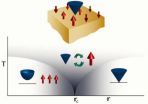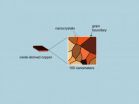(Press-News.org) WEST LAFAYETTE, Ind. — Low-risk Medicare patients entering home health care who received medication therapy management by phone were three times less likely to be hospitalized within the next two months, while those at greater risk saw no benefit, according to a study led by Purdue University.
The study helped determine which patients benefit most from medication therapy management by phone and a way to identify them through a standardized risk score, said Alan Zillich, associate professor of pharmacy practice at Purdue, who led the research.
"Hopefully, this study will help home health care providers target the intervention to those who it will help and improve patient health," he said. "It also tells us there are some patients for whom medication therapy management by phone doesn't work and that we need a different strategy to help these patients."
In medication therapy management a pharmacist evaluates the medications prescribed and how a patient is feeling to identify and resolve issues, including untreated conditions, drug interactions, adverse drug reactions, inappropriate drugs or doses and whether a patient is taking the medications as prescribed.
"We know that medication therapy management (MTM) improves adherence, improves outcomes and improves lives," said Patrick Dunham, CEO of Curant Health, which provided the medication therapy management interventions. "Reducing hospital admissions for the lowest-risk patients in this study by 86 percent is another powerful proof point for the value of MTM and its capability to simultaneously reduce costs and improve care across the health care continuum."
As Medicare may add incentives or penalties for home health care providers based on hospitalization rates, studies of medication management models could influence policy, Zillich said.
"Enhancing the quality of care for patients has always been the goal of health care providers, but the growing costs of Medicare and health care in general have put an even brighter spotlight on strategies to improve patient outcomes and reduce unnecessary costs," he said. "Medication therapy management is considered a valuable tool in this effort, but the best way to deliver it and the patients whom it will most benefit have not been well studied."
Zillich led a team of researchers who collaborated with the home health care organization Amedisys Inc., and pharmacists from Curant Health (formerly HealthStat Rx), who provided the medication therapy management intervention. A paper detailing the research was published in the journal Health Services Research and is available online. Amedisys Inc. funded the research.
"Just as we hypothesized, post-acute care interventions can make a positive impact on preventing issues the elderly may have with their complicated medication regimes: ultimately resulting in lower admissions," said Dr. Michael Fleming, chief medical officer for Amedisys.
The study followed 895 patients from 40 Amedisys home health care centers throughout the United States, with 415 receiving the intervention.
The intervention consisted of an initial phone call by a pharmacy technician to verify active medications, a pharmacist-provided medication regimen review and follow-up phone calls from a pharmacist one week later and as needed for 30 days.
The most common types of medication-related errors are identified soon after transitions of care take place and the first days are the most critical, Zillich said.
"Time is of the essence," he said. "The transition to home-based care - as with any type of transitions in care - is a vulnerable time for patients. It involves a switch in health care providers and sometimes a delay in the handoff of medical records. The patients likely have had significant changes or additions to their medications, and sometimes medication-related problems are just starting to appear."
The results showed no overall significant difference in the 60-day probability of hospitalization for those who received medication management therapy by phone versus those who did not. However, when the patients were evaluated based on their risk profiles, those in the lowest-risk group who received the service were three times more likely to remain out of the hospital 60 days after entering into home health care.
A patient's risk of hospitalization was determined through a standard set of nursing assessment items used by all Medicare-certified home health agencies called the "Outcome and Assessment Information Set" or OASIS-C, and the patients were divided into four risk categories.
"Most elderly patients requiring home health care are dealing with multiple chronic conditions and taking multiple medications," Zillich said. "When we say "low-risk" patients in this context, we are talking about the least sick of a very sick group of patients. I'm not sure why they benefited so much from this intervention while the other groups did not. One theory is that they are better able to receive and retain guidance from a pharmacist over the phone and perhaps face-to-face medication therapy management would better help the higher-risk patients."
The team plans to further explore intervention models that would be more effective for the higher-risk Medicare patients entering into home health care.
INFORMATION:
In addition to Zillich, authors of the paper include Margie Snyder, assistant professor of pharmacy practice at Purdue; Caitlin Frail, assistant professor of pharmacy at the University of Minnesota; Julie Lewis, former vice president of research and development for Amedisys Inc.; Donny Deshotels, director of analytics for Amedisys Inc.; Patrick Dunham, BSEE president and CEO of Curant Health; Heather Jaynes, research coordinator for Purdue's Department of Pharmacy Practice; and Jason Sutherland, associate professor in the School of Population and Public Health at the University of British Columbia.
Curant Health is a health care company that combines multiple patient-care processes to support individuals living with a chronic condition. Specially trained patient care managers and pharmacists form the foundation of the program and leverage MedPlan(™), Curant's enhanced, in-house electronic medical record. More information about the company is available at http://www.curanthealth.com/
Amedisys Inc. is a leading health care at home company delivering personalized home health and hospice care to more than 360,000 patients each year. More than 2,200 hospitals and 61,900 physicians nationwide have chosen Amedisys as a partner in post-acute care. For more information about the Company, visit: http://www.amedisys.com
The University of British Columbia (UBC)'s School of Population and Public Health is one of the most research-intensive units at UBC, with a long history of public health engagement, the School offers six graduate-level academic programs, as well as a residency program. For more information, visit http://www.spph.ubc.ca
Writer and media contact: Elizabeth K. Gardner, 765-494-2081, ekgardner@purdue.edu
Additional media contact: Curant Health: Kristin Lindsey, marketing director, 866-437-8040 ext. 253, klindsey@curanthealth.com
Sources: Alan Zillich, phone, 317-880-5430, azillich@purdue.edu
Dr. Michael Fleming, 225-299-3275, Michael.fleming@amedisys.com
Jason Sutherland, 202-445-5505, jsutherland@chspr.ubc.ca
ABSTRACT
A randomized, controlled pragmatic trial of telephonic medication therapy management to reduce hospitalization in home health patients
Alan J. Zillich, Margie E. Snyder, Caitlin K. Frail, Julie L. Lewis, Donny Deshotels, Patrick Dunham, Heather A. Jaynes, Jason M. Sutherland
Objective: To evaluate the effectiveness of a telephonic medication therapy management (MTM) service on reducing hospitalizations among home health patients.
Setting: Forty randomly selected, geographically diverse home healthcare centers in the United States.
Design: Two-stage, randomized, controlled trial with 60-day follow up. All Medicare-insured home healthcare patients were eligible to participate. Twenty-eight consecutive patients within each care center were recruited and randomized to usual care of MTM intervention. The MTM intervention consisted of the following: 1) initial phone call by a pharmacy technician to verify active medications, 2) pharmacist-provided medication regimen review by telephone, and 3) follow-up pharmacist phone calls at day seven and as needed for 30 days. The primary outcome was 60-day all-cause hospitalization.
Data Collection: Data were collected from in-home nursing assessments using the OASIS-C. Multivariate logistic regression modeled the effect of the MTM intervention on the probability of hospitalization while adjusting for patients' baseline risk of hospitalization, number of medications taken daily, and other OASIS-C data elements.
Principal Findings: A total of 895 patients (intervention n=415, control n=480) were block-randomized to the intervention or usual care. There was no significant difference in the 60-day probability of hospitalization between the MTM intervention and control groups (Adjusted OR: 1.26, 95% CI:0.89-1.77, p=0.19). For patients within the lowest baseline risk quartile (n=232), the intervention group was three times more likely to remain out of the hospital at 60 days (Adjusted OR: 3.79, 95% CI:1.35-10.57, p=0.01) compared to the usual care group.
Conclusions: This MTM intervention may not be effective for all home health patients; however, for those patients with the lowest-risk profile, the MTM intervention prevented patients from being hospitalized at 60 days.
Medication therapy management works for some but not all home health patients
2014-04-09
ELSE PRESS RELEASES FROM THIS DATE:
UC-led research finds chips with olestra cause body toxins to dip
2014-04-09
According to a clinical trial led by University of Cincinnati researchers, a snack food ingredient called olestra has been found to speed up the removal of toxins in the body.
Results are reported in the April edition of the Journal of Nutritional Biochemistry.
The trial demonstrated that olestra—a zero-calorie fat substitute found in low-calorie snack foods such as Pringles—could reduce the levels of serum polychlorinated biphenyls (PCBs) in people who had been exposed to PCBs.
High levels of PCBs in the body are associated with an increase in hypertension and diabetes. ...
Gusev Crater once held a lake after all, says ASU Mars scientist
2014-04-09
TEMPE, Ariz. - If desert mirages occur on Mars, "Lake Gusev" belongs among them. This come-and-go body of ancient water has come and gone more than once, at least in the eyes of Mars scientists.
Now, however, it's finally shifting into sharper focus, thanks to a new analysis of old data by a team led by Steve Ruff, associate research professor at Arizona State University's Mars Space Flight Facility in the School of Earth and Space Exploration. The team's report was just published in the April 2014 issue of the journal Geology.
The story begins in early 2004, when NASA ...
One kind of supersymmetry shown to emerge naturally
2014-04-09
UC Santa Barbara physicist Tarun Grover has provided definitive mathematical evidence for supersymmetry in a condensed matter system. Sought after in the realm of subatomic particles by physicists for several decades, supersymmetry describes a unique relationship between particles.
"As yet, no one has found supersymmetry in our universe, including at the Large Hadron Collider (LHC)," said the associate specialist at UCSB's Kavli Institute for Theoretical Physics (KITP). He is referring to the underground laboratory in Switzerland where the famous Higgs boson was identified ...
Violence intervention program effective in Vanderbilt pilot study
2014-04-09
Violent behavior and beliefs among middle school students can be reduced through the implementation of a targeted violence intervention program, according to a Vanderbilt study released in the Journal of Injury and Violence Research.
Manny Sethi, M.D., assistant professor of Orthopaedic Surgery and Rehabilitation, and his Vanderbilt co-authors evaluated 27 programs nationwide as part of a search for an appropriate school-based violence prevention program.
Their findings led to a single, evidence-based conflict resolution program that was evaluated in a pilot study of ...
Stanford scientists discover a novel way to make ethanol without corn or other plants
2014-04-09
Stanford University scientists have found a new, highly efficient way to produce liquid ethanol from carbon monoxide gas. This promising discovery could provide an eco-friendly alternative to conventional ethanol production from corn and other crops, say the scientists. Their results are published in the April 9 advanced online edition of the journal Nature.
"We have discovered the first metal catalyst that can produce appreciable amounts of ethanol from carbon monoxide at room temperature and pressure – a notoriously difficult electrochemical reaction," said Matthew ...
Novel approach to accelerate metabolism could lead to new obesity treatment
2014-04-09
BOSTON – By manipulating a biochemical process that underlies cells' energy-burning abilities, investigators at Beth Israel Deaconess Medical Center (BIDMC) have made a novel discovery that could lead to a new therapy to combat obesity and diabetes.
Published in the April 10 issue of the journal Nature, the new findings show that reducing the amount of nicotinamide N-methyltransferase (NNMT) protein in fat and liver dramatically reduces the development of obesity and diabetes in mice.
'With this discovery, we now have a means of metabolic manipulation that could ...
A bad penny: Cancer's thirst for copper can be targeted
2014-04-09
DURHAM, N.C. – Drugs used to block copper absorption for a rare genetic condition may find an additional use as a treatment for certain types of cancer, researchers at Duke Medicine report.
The researchers found that cancers with a mutation in the BRAF gene require copper to promote tumor growth. These tumors include melanoma, the most dangerous form of skin cancer that kills an estimated 10,000 people in the United States a year, according to the National Cancer Institute.
"BRAF-positive cancers like melanoma almost hunger for copper," said Christopher M. Counter, ...
UC San Diego researchers develop bacterial 'FM radio'
2014-04-09
Programming living cells offers the prospect of harnessing sophisticated biological machinery for transformative applications in energy, agriculture, water remediation and medicine. Inspired by engineering, researchers in the emerging field of synthetic biology have designed a tool box of small genetic components that act as intracellular switches, logic gates, counters and oscillators.
But scientists have found it difficult to wire the components together to form larger circuits that can function as "genetic programs." One of the biggest obstacles? Dealing with a small ...
New 'switch' could power quantum computing
2014-04-09
Using a laser to place individual rubidium atoms near the surface of a lattice of light, scientists at MIT and Harvard University have developed a new method for connecting particles — one that could help in the development of powerful quantum computing systems.
The new technique, described in a paper published today in the journal Nature, allows researchers to couple a lone atom of rubidium, a metal, with a single photon, or light particle. This allows both the atom and photon to switch the quantum state of the other particle, providing a mechanism through which quantum-level ...
Synthetic collagen promotes natural clotting
2014-04-09
Synthetic collagen invented at Rice University may help wounds heal by directing the natural clotting of blood.
The material, KOD, mimics natural collagen, a fibrous protein that binds cells together into organs and tissues. It could improve upon commercial sponges or therapies based on naturally derived porcine or bovine-derived collagen now used to aid healing during or after surgery.
The lab of Jeffrey Hartgerink, a chemist and bioengineer based at Rice's BioScience Research Collaborative, developed synthetic collagen several years ago. The lab's analysis of KOD ...




